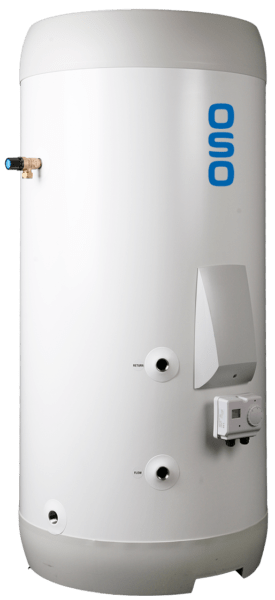
In many areas of the plumbing and heating industry the old adage ‘you get what you pay for’ has real clout. However, when you look at hot water storage, many perceive one hot water cylinder to be the same as another. So, is this the case?
Stuart Elsy, managing director of OSO Hotwater, looks at the features to look out for and what installers should consider to ensure they are recommending the best.
Where boilers are concerned, homeowners are often prepared to pay for what they know will offer them quality, efficiency and reliability. Perhaps considered a functional add on with even less visible, it is easy to see why many feel that one energy efficient unvented hot water storage cylinder will be the same as any other on the market.
Yet, it is an integral part of the pressurized heating system and, with many variations in quality, efficiency and innovation out there, what is specified will undoubtedly have an impact on the effectiveness of the high pressure heating system as a whole. Opting for a top-rated boiler and pairing this with a cheaper pressurized hot water cylinder is inevitably going to adversely affect the end result.
Thankfully, with advances in stainless steel unvented cylinder technology now available, the new generation of mains pressure unvented cylinders now available offer considerable advantages over older products and can provide greater opportunities for house design and space utilisation.
Vacuum Packed Efficiency
The definition of a high-performance cylinder has now shifted from a cylinder that heats up quickly, to one that cools down slowly.
Heat loss is the key factor here and keeping this to a minimum is the parameter by which indirect cylinders are assessed for SAP and ERP.
Where heat loss was once a bare cylinder covered with an ill-fitting jacket, the move to spray foam insulation made notable steps to improve performance and is still used in many vented cylinders, although at an increased thickness. Now, almost all unvented and thermal store products tend to feature injection foam, which again ensures improvement in the speed in which heated water cools.
However, if you are looking to couple a highly effective boiler with hot water storage that can follow suit, opting for vacuum panel insulation will provide the best result.
The vacuum panel on its own can improve efficiency by 30-50% even when compared to injection foam models. The way this works is simple. Heat cannot travel through a vacuum, and a 10mm thick vacuum panel has the same effect as 60mm of the very best foam insulation.
The panel is wrapped around the cylinder wall, and units is then “double lagged” with a layer of foam insulation that further reduces heat loss but also gives stability to the cylinder casing and protect the vacuum panel.
With all cylinders currently on the market now receiving an ERP rating from A-C, spotting the better performing models is a much simpler task than previously. Poor performing cylinders below a C rating are now illegal, but there are still significant differences in operation.
Achieving the golden A-rated hot water cylinder range has eluded many key industry players but by continuing to innovate and by utilising this award-winning vacuum panel insulation, OSO has seen its award winning A rated Delta range meet that target across all sizes. Specifying a large A-rated model can save up to £80 a year in energy costs compared to a 15-20-year-old cylinder that it could be replacing.
Where Insulation Counts
Outside of vacuum panel models, cylinder ranges with better ratings tend to have thicker insulation.
A cylinder with 50mm of foam insulation is already well insulated. Marginal gains can be made by increasing the thickness to 60 or 70mm. Beyond that any gains are more than offset by the practical difficulties of squeezing a bulkier cylinder into a narrow airing cupboard.
Units with this level of insulation open up the installation possibilities too as they don’t always need to fit into an airing cupboard. A loft or a garage can provide an ideal alternative. The small amount of additional heat loss that will occur because the ambient temperature is lower in those environments will be a small cost, when compared to the addition space created by removal of the cylinder from the first floor.
Electric Gains
Gains can be made where electric cylinders are concerned too. Direct electric hot water cylinders are assessed for ERP on their thermal efficiency in line with heat in vs heat out. Cylinder insulation is clearly very important in this respect, but a new advance in smart controls by OSO has made a significant stride forward in cutting energy bills.
The award-winning water heater, OSO Super SX iQ learns the hot water usage habits of a household, predicts demand and limits energy input to match demand. The resultant energy cost saving will amount to up to £60 per year at today’s electricity prices, and these prices are not going to go down in the future.
Space Efficiency
Efficiency is not always just about energy efficiency. Space efficiency can be equally important to a householder.
Back in the mists of time (1989), OSO invented the bubble top system. Many other manufacturers “borrowed” it during the 1990s, some more successfully than others. OSO dropped the bubble top unit some time ago to replace it with an improved design on the award- winning hot water cylinder the Super Series that has all the space saving advantages of the bubble unit, but which dispenses with the annual bubble replenishment procedure normally recommended as part of a service. The Super Series design is now a patented design.
Cylinders with separate expansion vessels do the job but take up a lot of space. Bubble top units are more space efficient, but the all-on-top design of the Super Series with twin mini-expansion vessels concealed under a lid, are guaranteed not to lose their charge for at least 5 years and gives a space saving and maintenance friendly alternative.
The space saving features of Super Series are accentuated with the SX IQ because it heats and stores water at 70°C; 10°C higher than most other units. The cylinder contains a blending valve in its multifunction valve and blends the water to 60°C at the outlet, thus eliminating any risk of scalding. This extra energy storage means that a smaller cylinder can be specified, saving further space and in practical terms means that a washing machine can be stored underneath the cylinder up to 210 litres in a standard airing cupboard. No other product has that flexibility.
Lagged for efficiency
To maintain efficiencies, it is equally important to ensure that the interface of pipework between boiler and cylinder is correctly lagged and that modern heating controls are used.
Heating costs in indirect cylinders can also be affected by hard water. Opting for a coil which is smooth will attract and harbour far less limescale than a ribbed or finned coil, cutting the effect of Limescale acts as insulation between primary and secondary water. Building regulations Part L recommends that hard water is treated to reduce calcium and preserve the efficiency of the system. In the worst cases, cylinders can just fill up with limescale, and because the South-East and East of England in particular are known hard water areas, the design of a heat-exchange in a cylinder should always be a factor to consider for installers in those areas.
So no, not all unvented and vented cylinders are the same and this should be considered before making a recommendation. Quality, insulation, efficiency, space saving opportunities and improvements technology make a real difference to the overall system and vary from product to product. In the same way customers way up the pros and cons of a boiler, the same needs to be done on the cylinder front to ensure the whole system meets, or exceeds, expectation.


